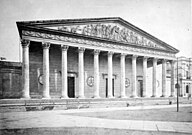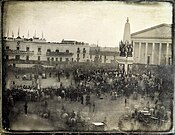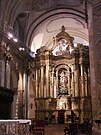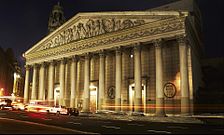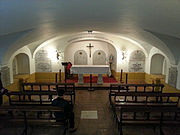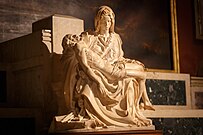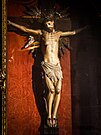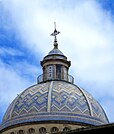Buenos Aires Metropolitan Cathedral
It is located in the city center, overlooking Plaza de Mayo, on the corner of San Martín and Rivadavia streets, in the San Nicolás neighbourhood. It is the mother church of the Archdiocese of Buenos Aires and held the rank of Primatial church of Argentina from 1822 to 2024. The cathedral was declared National Historic Monument in 1942.
History
First cathedral
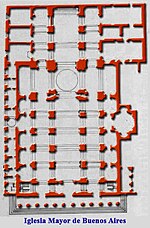
When Juan de Garay arrived from Asunción to found the city of La Trinidad y Puerto de Buenos Aires on June 11, 1580, he set aside for the main church or cathedral the same quarter of a city block that it occupies today. Two brothers from the Jesuit Order, architect one and bricklayer the other completed this first cathedral, as well as several other religious buildings of this early city. In the act of foundation, made by Juan de Garay, it is read: "Being in this port of Santa María de Buenos Aires, which is in the Province of the Río de la Plata, again called Nueva Vizcaya, I make and found in the said seat and port a city, which 'local people' [translating 'pueblo'] with soldiers and people that I have and have brought for it, the church of which I put its dedication of the Holy Trinity, which is and will be the major parish church contained and marked in the square that I have made of the said city [...]". Regarding the ecclesiastical jurisdiction, during this century the new city depended on, the diocese of the Río de la Plata (in today's Paraguay), created by Pope Paul III on July 1, 1547 with seat in Asunción.
The major parish church was a modest construction with adobe and wood walls, had two towers that gave the current Avenida Rivadavia the former name of Calle de las Torres, which in 1605 Governor Hernandarias ordered to demolish for being too old and indecent. We do not know what proportions would have the one that was built in its place with wood brought expressly from Paraguay. Years later, in 1616, its roof threatened to collapse and the parish, together with the Most Holy statue, had to move to the Church of San Francisco, and while projects were made to reform it, requesting for it the pecuniary contribution of the faithful, the church ended up collapsing because it was poorly built and with rotten willow wood. Neither the Cabildo, Justice and Regiment of the city lost heart and immediately chartered a ship to Paraguay to acquire and bring the necessary wood for the rebuilding of the temple. The work began in January 1618. According to the budget of Pascual Ramírez, who would carry out the work, the cost would be 1,100 pesos. We do not have exact information on the collection of the money, but we do know that by the end of that same year the work on the church was finished. But there was a difficulty: it was smaller than the previous one, so much so that in 1621 there was already talk of building another one to be used as a cathedral.
In the meantime, in Madrid and in Rome, the procedures for the creation of the Diocese of Buenos Aires were being carried out. The bull of canonical erection of this church as cathedral by Pope Paul V is dated April 6, 1620 and its execution took place on June 26, 1622 by its first bishop, the Carmelite friar Pedro Carranza, in a solemn meeting with the authorities and the people, which means that on that date he took possession of the diocese. The bishop in his letter of May 4 of that same year he wrote to the king: "it is so indecent (the cathedral) that in Spain there are places in the fields of shepherds and cattle more comfortable and clean; in the church there is no sacristy, but an old, short and indecent one of reeds, raining all over itself, with a great poverty of ornaments." "The Blessed Sacrament is in a rough and poorly standing wooden box." "And as far as the building is corcerned, it is necessary to board it up and accommodate it, otherwise it will all fall to the ground and we will go to a convent church to make cathedral". This was, then, what we can call the first cathedral.
Second cathedral
When the third bishop of Buenos Aires, Friar Cristóbal de la Mancha y Velazco arrived at his see on October 6, 1641, he found the cathedral, if not in a ruinous state, at least very deteriorated. So he immediately conceived the idea of building a new cathedral and communicated it to the king on November 19, 1662. According to the plan he enclosed, the temple was to have three naves; for its construction, 5,000 pesos would be needed, a sum he requested from the royal treasury. In the person of the excellent governor Don José Martínez de Salazar, the bishop found someone who would collaborate in the construction of the temple not only with his influence, but even with money of his own. In 1671 the cathedral was finished, it consisted of three naves, a wooden roof and a tower, it was of regular proportions.
But behold, a work with so many appearances of solidity, after seven years, because of the inferior quality of some materials used in its construction, began to show signs of its inevitable ruin. This is the second cathedral.
Due to the bad quality of its building materials, the tower and the roof of this church fell down in the early 1680s. The whole church was again rebuilt, starting in 1684, under bishop Azcona Imberto. In 1695 the building was almost finished, with the flanking towers of the façade and the sacristy still to be completed.
In the early 18th century the works were slow, and the first tower was finished only around 1721. The second tower was begun in 1722 and finished around 1725. The main façade was redesigned between 1725 and 1727 by the Italian Jesuit Giovanni Bianchi (also spelled Blanqui). The design of the new façade was directly inspired by Italian Mannerist architecture.
Definitive building
On the night of May 23, 1752, the nave of the cathedral collapsed. The only portions still standing were the façade and towers, but the rest of the building needed to be completely rebuilt once again. Italian architect Antonio Masella was put in charge of the project, and the works began already in 1753. Masella designed a majestic church, much larger than the previous structure, with a three-aisled nave covered with barrel vaulting and lateral chapels. A dome was to sit over the crossing. Upon completion of the dome, however, fissures in the structure were detected and it had to be rebuilt. Masella was removed from the project and prosecuted by the authorities, although later acquitted.
The dome was rebuilt by Portuguese architect Manuel Álvarez de Rocha after 1770. The façade by Blanqui and the towers were finally demolished in 1778, since they were too small in comparison to the scale of the new cathedral. An elegant project for a new façade with two flanking towers, combining Rococo and Neoclassical elements, was presented by the Portuguese military engineer José Custódio de Sá e Faria, but financial constraints prevented the realisation of the project. The cathedral was consecrated in 1779 without façade.



